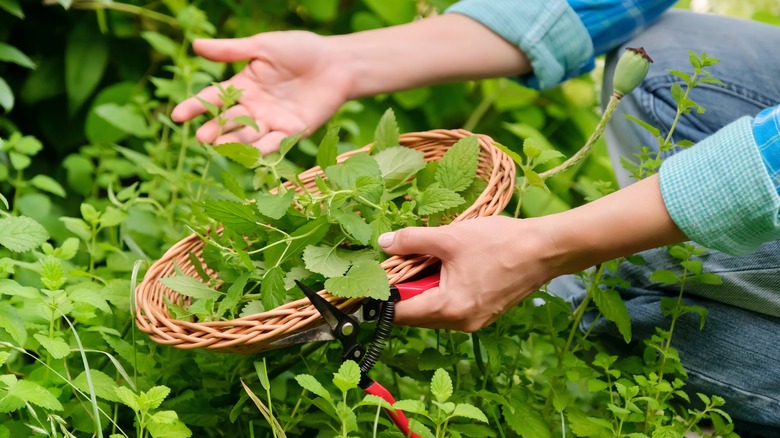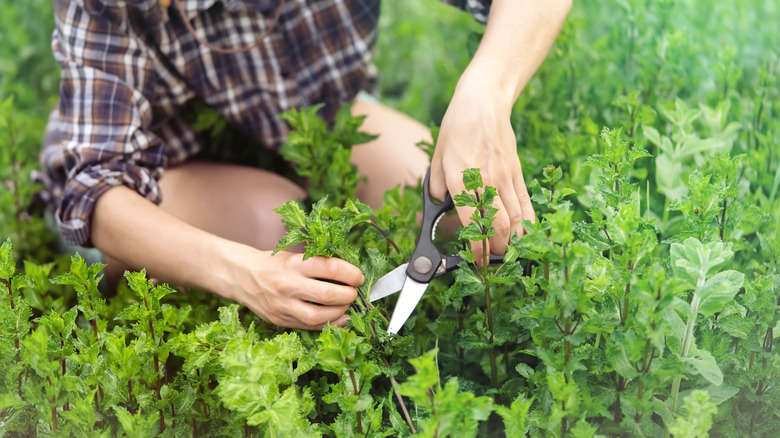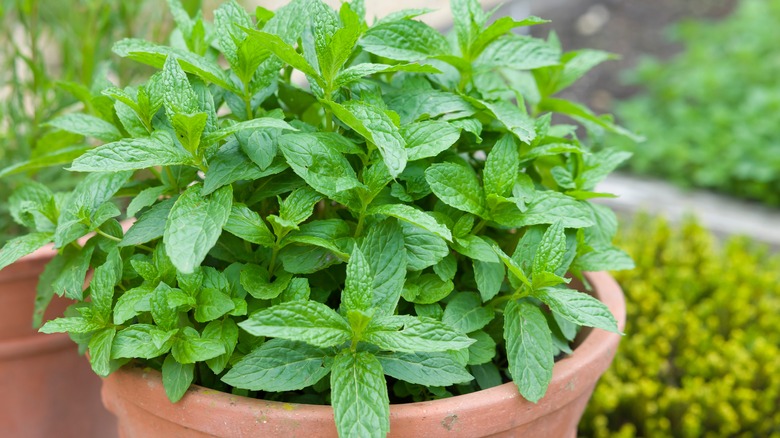How To Prune Mint To Keep The Herb From Taking Over Your Back Yard
Mint is the shared name of a group of herbs, mainly of the Mentha genus, which has around 42 subspecies, 15 hybrids, and hundreds of cultivars, according to a 2021 article in Molecules. These plants are phenomenally aromatic and have been prized for centuries by medics and cooks alike for their flavoring and healing properties. They are identifiable by their fresh, cool aroma and the squareness of their stems.
Mint is a perennial herb that thrives in many conditions, ultimately preferring moist but well-draining soil, similar to their native riverbanks, according to Almanac. Their prolific growing habit means that besides their utility to a kitchen, mints are also used for air freshening and are simple to grow ground cover or accent plants. However, there is one drawback to be aware of when it comes to this useful and easy-to-grow herb.
As PH & G explained, mint sends out runners above ground, as well as roots underground, in an effort to spread quickly. In addition, mint is a thirsty plant, which can lead to it dominating the water in the top inch of soil over a large area, choking off surrounding plants. Mint shoots also grow quite quickly, meaning that before other young plants can establish themselves, they're already shaded out by this plant's leaves. So, unless you want a whole garden full of mint, it's important to have a pruning strategy in place to make sure you keep on top of the spread! Here's what you need to know.
How to prune mint
According to Utah State University Extension, over-pruning a mint plant is a difficult task. However, especially given its talent for taking over, you should feel confident about cutting a lot of it during the growing season. Even if, for whatever reason, your plant isn't looking its best — Your Indoor Herbs and Garden strongly recommends good pruning to cure what ails it.
Each winter, cut mint plants down to 1 inch or so from the ground to limit pests and disease. When they bounce back, begin pruning when it has grown beyond 3 to 4 inches above the soil level; according to Heeman's, this will be the base height of the herb. Next, cut each stem, leaving a couple of leaves. That stem will stop growing, and the two leaves will become new stems. This will keep your mint plant compact.
Anytime that you see flowers forming at the top of the stems, you will probably want to cut them off. Mint leaves lose their flavor and texture if their plant begins using its energy to produce pretty flowers, according to Jim's Mowing. Having said that, if you have space or are able to be hands-on in the garden, Kellogg Garden Products made the point that mint flowers are very popular with pollinators — honeybees especially. So if you want to encourage pollinators in your garden, consider letting some of your mint plants go to flower, but be aware that this increases the risk of spreading.
Other tips to contain mint
You can do several things ahead of time when you plant your mint to reduce the need for pruning and help curtail the risk of spreading. According to The Herbal Academy, the best way to control mint is by containing it, i.e., planting in pots or containers, even if you want to plant into a bed. The pot's rim gives you an easy-to-check reference point for how much space the mint should be allowed in the bed, and the walls of the vessel provide a physical barrier to its root structure. The roots are one of the main ways the plant spreads, so this is quite effective.
Containing the roots with underground barriers is key, but be aware that mint can also spread through runners. These low, horizontal branches creep across the soil and take over new space. If they run into a barrier, they will grow upwards and turn into regular mint sprigs. This is why it's worth leaving 1 to 3 inches of whatever container you're using above the soil, per Hobby Farms — they use a fabric planter bag rather than a pot.
So, in order to keep mint from taking over your backyard, you'll want to regularly prune in the right place and plant it in a container with at least 1 inch of a lip above the soil level, to contain both roots and runners.


